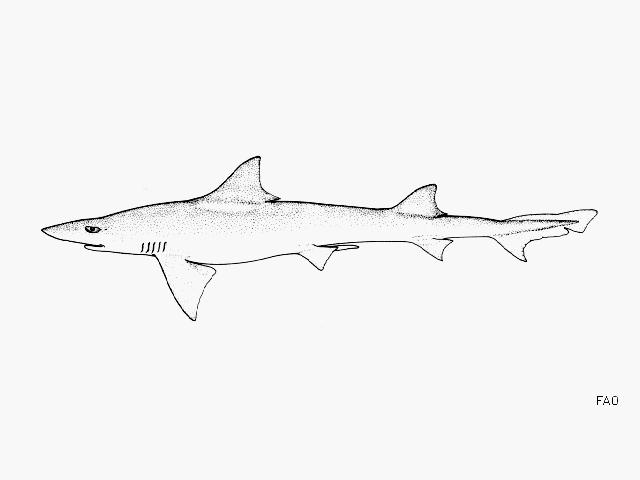Mustelus higmani
Springer & Lowe, 1963
Smalleye smooth-hound
Classification: Elasmobranchii Carcharhiniformes Triakidae
Reference of the original description
A new smooth dogshark, Mustelus higmani, from the Equatorial Atlantic coast of South America. Copeia, 1963(2), 245–251
A new smooth dogshark, Mustelus higmani, from the Equatorial Atlantic coast of South America. Copeia, 1963(2), 245–251
Image of the original description
Image in copyright.
Image in copyright.
Types
Mustelus higmani
Holotype: USNM: 156930; Paratype: USNM: 196546; USNM: 187938; USNM: 187723; USNM: 187721; USNM: 187720; USNM: 187698; USNM: 187697; USNM: 187693; USNM: 221724; USNM: 187695;
Mustelus higmani
Holotype: USNM: 156930; Paratype: USNM: 196546; USNM: 187938; USNM: 187723; USNM: 187721; USNM: 187720; USNM: 187698; USNM: 187697; USNM: 187693; USNM: 221724; USNM: 187695;
Description :
Citation: Mustelus higmani Springer & Lowe, 1963: In: Database of modern sharks, rays and chimaeras, www.shark-references.com, World Wide Web electronic publication, Version 12/2025
Please send your images of "Mustelus higmani" to info@shark-references.com

Mustelus higmani Springer & Lowe, 1963, © FAO, www.fish-base.org

Mustelus higmani Springer & Lowe, 1963, © FAO, www.fish-base.org
Common names
 Cazón,
Cazón,  Musola amarilla,
Musola amarilla,  Viuda,
Viuda,  Emissole ti-yeux,
Emissole ti-yeux,  Emissole tiyeux,
Emissole tiyeux,  Smalleye smooth hound,
Smalleye smooth hound,  Smalleye smooth-hound,
Smalleye smooth-hound,  Cação
Cação
 Cazón,
Cazón,  Musola amarilla,
Musola amarilla,  Viuda,
Viuda,  Emissole ti-yeux,
Emissole ti-yeux,  Emissole tiyeux,
Emissole tiyeux,  Smalleye smooth hound,
Smalleye smooth hound,  Smalleye smooth-hound,
Smalleye smooth-hound,  Cação
Cação
Short Description
Diagnosis after Compagno, 1984 [517]: Body fairly slender. Head moderately long, prepectoral length 19 to 24% of total length; snout long and sharply angular in lateral view, preoral snout 6.9 to 10.3% of total length, preorbital snout 6.9 to 9.9% of total length; internarial space broad, 2.7 to 3.8% of total length; eyes small, eye length 2.8 to 3.4 times in preorbital snout and 2.2 to 3.4°!0 of total length; interorbital space very broad, 4.5 to 6.3% of total length; mouth moderately long, slightly longer than eye length, 2.3 to 3.6% of total length; upper labial furrows about as long as lowers, upper furrows 0.8 to 1.8% of total length; teeth molariform and asymmetric, with cusp low and blunt or pointed; buccopharyngeal denticles covering anterior half of palate and mouth floor. Interdorsal space 17 to 23% of total length; trailing edges of dorsal fins denticulate, without bare ceratotrichia; first dorsal fairly falcate, its posterior margin nearly vertical from apex, its midbase about equidistant between pectoral and pelvic bases or slightly closer to pectorals; pectoral fins fairly small, length of anterior margins 11 to 14% of total length, width of posterior margin 6.7 to 10% of total length; pelvic fins moderately large, anterior margin length 6.7 to 10% of total length; anal height 2.9 to 4.6% of total length; analcaudal space greater than second dorsal height, 6 to 9.2% of total length; ventral caudal lobe more or less falcate in adults. Crowns of lateral trunk denticles mostly strongly tricuspidate, with longitudinal ridges extending their entire length. Skeleton not hypercalcified in adults; palatoquadrates not subdivided; monospondylous precaudal centra 34 to 39, diplospondylous precaudal centra 43 to 50, precaudal centra 80 to 90. Colour uniform grey or grey-brown, above, light below, no white or dark spots or dark bars. Development viviparous. Size small, adults 43 to 64 cm.
Diagnosis after Compagno, 1984 [517]: Body fairly slender. Head moderately long, prepectoral length 19 to 24% of total length; snout long and sharply angular in lateral view, preoral snout 6.9 to 10.3% of total length, preorbital snout 6.9 to 9.9% of total length; internarial space broad, 2.7 to 3.8% of total length; eyes small, eye length 2.8 to 3.4 times in preorbital snout and 2.2 to 3.4°!0 of total length; interorbital space very broad, 4.5 to 6.3% of total length; mouth moderately long, slightly longer than eye length, 2.3 to 3.6% of total length; upper labial furrows about as long as lowers, upper furrows 0.8 to 1.8% of total length; teeth molariform and asymmetric, with cusp low and blunt or pointed; buccopharyngeal denticles covering anterior half of palate and mouth floor. Interdorsal space 17 to 23% of total length; trailing edges of dorsal fins denticulate, without bare ceratotrichia; first dorsal fairly falcate, its posterior margin nearly vertical from apex, its midbase about equidistant between pectoral and pelvic bases or slightly closer to pectorals; pectoral fins fairly small, length of anterior margins 11 to 14% of total length, width of posterior margin 6.7 to 10% of total length; pelvic fins moderately large, anterior margin length 6.7 to 10% of total length; anal height 2.9 to 4.6% of total length; analcaudal space greater than second dorsal height, 6 to 9.2% of total length; ventral caudal lobe more or less falcate in adults. Crowns of lateral trunk denticles mostly strongly tricuspidate, with longitudinal ridges extending their entire length. Skeleton not hypercalcified in adults; palatoquadrates not subdivided; monospondylous precaudal centra 34 to 39, diplospondylous precaudal centra 43 to 50, precaudal centra 80 to 90. Colour uniform grey or grey-brown, above, light below, no white or dark spots or dark bars. Development viviparous. Size small, adults 43 to 64 cm.
Distribution
Western Atlantic: northern coast of Venezuela southward to Brazil. Source: www.gbif.org
Western Atlantic: northern coast of Venezuela southward to Brazil. Source: www.gbif.org
Human uses
fisheries: commercial
fisheries: commercial
Biology
Viviparous, with a yolk-sac placenta [517]. Found on the continental shelf on muddy, sandy and calcareous bottoms. Also occurs in shallow brackish water. Feeds mainly on crustaceans and occasionally on bony fishes, squids, and coelenterates.
Viviparous, with a yolk-sac placenta [517]. Found on the continental shelf on muddy, sandy and calcareous bottoms. Also occurs in shallow brackish water. Feeds mainly on crustaceans and occasionally on bony fishes, squids, and coelenterates.
Remarks
shark-references Species-ID=3797;
shark-references Species-ID=3797;
















